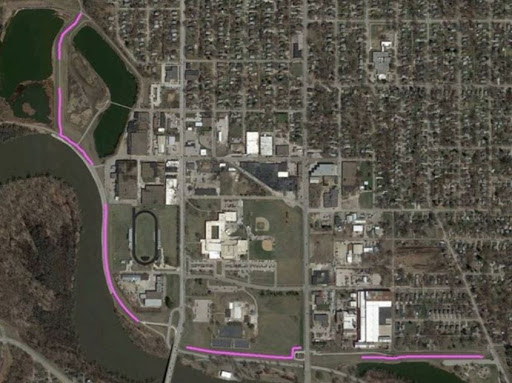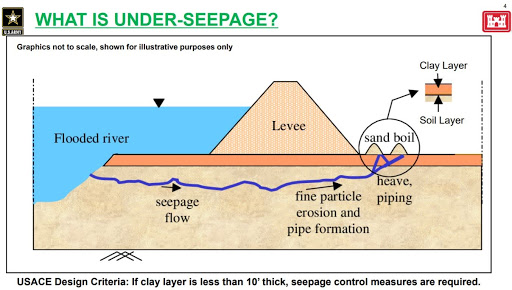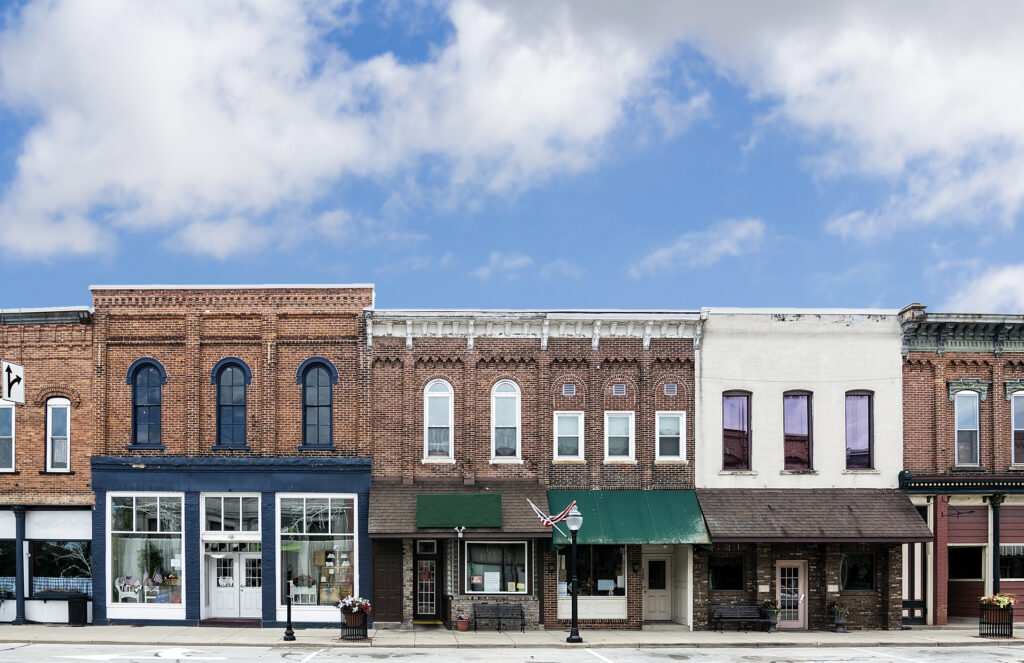Birdland levee repairs expected to cost up to $12 million
Design flaws are causing water to seep under the levee, potentially causing erosion

KATHY A. BOLTEN Apr 30, 2020 | 5:31 am
3 min read time
683 wordsAll Latest News, Energy, Government Policy and Law, Real Estate and DevelopmentThe lavender on the aerial view of the Birdland levee, located along the east side of the Des Moines River, indicates areas where there is concern by the Army Corps of Engineers that under-seepage will occur. The Corps is now planning to make repairs to the levee, which was rebuilt about nine years ago. Photo courtesy of Army Corps of Engineers
In 2002, the Army Corps of Engineers completed a study of the Birdland levee system that was supposed to protect North High School and surrounding homes and businesses from floods.
In 2008, a levee breach caused millions of dollars in damage to the Birdland area.
Two years later, and without any further analysis, construction of a new levee system began. The construction portion of the project, completed in late 2011, cost $8.1 million. Subsequently, the city began reinvesting in the area. New homes have been built, businesses have made improvements to their properties, and a new stadium has been constructed.
Now Corps officials have determined that about two-thirds of the 1.7-mile levee do not meet federal engineering standards for under-seepage. It will cost up to $12 million to bring the levee up to Corps standards, officials estimated. The city of Des Moines will be expected to contribute 35% of the cost, or up to $4.2 million.
The City Council is expected to vote Monday on a request to provide $210,000 to help pay for new engineering designs, which will be completed by the Corps.
Flaws with the levee were discovered in late 2017 by an engineer hired by the city to design a detention basin east of Birdland Pool. Further analysis by the Corps confirmed the engineer’s findings.
There are no immediate threats to nearby residences, schools or businesses, said Jason Smith, senior project manager for the Corps. But, he added, “Continued high-water events may increase the risk associated with the under-seepage issue.”
Under-seepage occurs when pressure from the river pushes water under the levee, moving sand and bedrock out of its way. On the non-river side of the levee, sand boils can form, an indication that under-seepage is occurring, Smith explained. The erosion caused by the under-seepage could reduce the level of protection the levee was designed to provide, he said.
The layer of clay under the levee should be at least 10 feet thick in order to minimize the risk of sand boils occurring, Smith said. In some areas of the levee, the clay layer is below the 10-foot threshold.
In the early 2000s, borings of the layers of earth under the levee were taken, which showed an adequate thickness clay. However, Smith said, the boring samples “were not representative of the entirety of the levee.”
Additional studies were not done after the 2008 flood, or after Congress appropriate money in 2010 for the reconstruction of the Birdland levee, Smith said. “We had a very short [time period] in which to get the project constructed, so we relied on the information we had collected in the past. … It was the best available data at the time.”
Solutions to fixing the problem include building a cutoff wall that would be installed down the center of the levee and reach to the bedrock; building relief wells on non-river side of the levee that would be spaced 10 to 25 feet apart; or installing toe drains, which are designed to capture seepage.
The options all have pros and cons, Smith said. The solution will likely be a combination of the three, he said.
The Corps has received funding to prepare designs to repair the levee, which will take 12 to 18 months, Smith said. Congressional approval will be needed to move forward with the project, which will take up to two years to complete after funding is secured.
The cost of the new design work is estimated at $600,000. The city’s portion of that cost is about $210,000. The council is expected to approve the expense at its meeting on Monday.
A graphic designed by the Army Corps of Engineers explains under-seepage, which is happening along the Birdland levee system.











